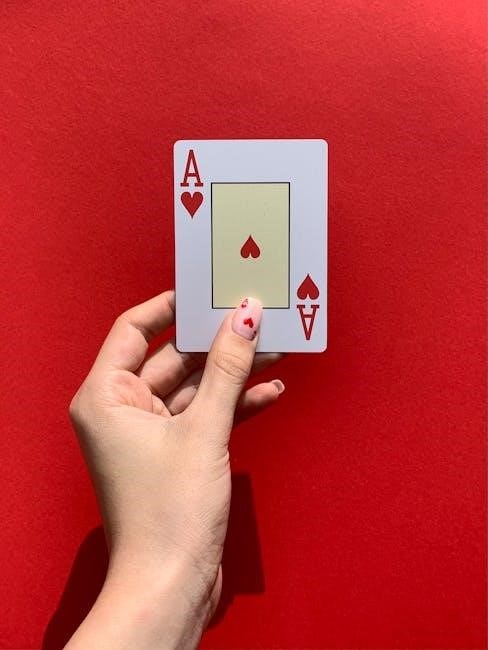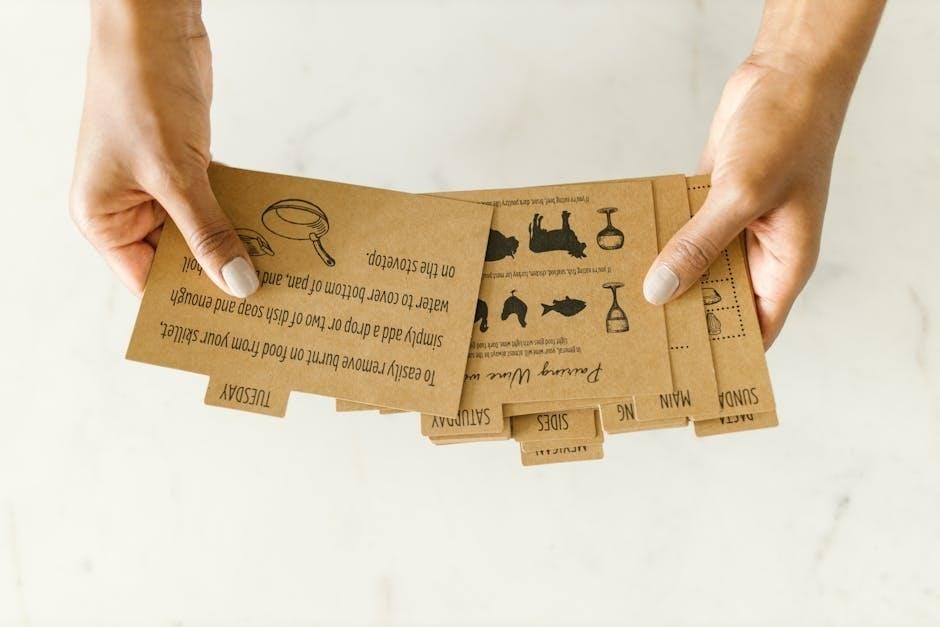Hand and Foot is a strategic rummy-style card game inspired by Canasta‚ emphasizing teamwork and strategy. Played with multiple decks‚ it involves two piles: Hand and Foot‚ with wild cards adding excitement. This popular North American game offers a unique blend of skill and fun‚ making it a favorite among card enthusiasts of all skill levels.
1.1 Overview of the Game
Hand and Foot is a dynamic rummy-style card game where players aim to discard all their cards by forming valid melds. Using multiple decks‚ including wild cards like Jokers and Deuces‚ the game involves two distinct piles: the Hand and the Foot. Typically played in teams of four‚ it accommodates up to six players. The objective is to create sets of three to seven cards of the same rank. The game proceeds through multiple rounds‚ with strategic planning and effective use of wild cards being key to success. Team coordination enhances gameplay‚ making it a popular choice for gatherings.
1.2 Brief History and Popularity
Hand and Foot is a North American card game inspired by Canasta‚ offering a fresh take on rummy. Its engaging gameplay and strategic depth have made it a beloved choice for social gatherings and tournaments. Originating as a simpler alternative to Canasta‚ it has gained popularity for its accessible rules and teamwork aspects‚ allowing for a fun and competitive experience among friends and family. Its adaptability and variety of house rules further enhance its widespread appeal.
1.3 Basic Objective of the Game
The primary goal in Hand and Foot is to be the first player to discard all your cards by forming valid melds. Players must first empty their Hand pile before accessing the Foot pile. Melds‚ which are sets of three to seven cards of the same rank‚ are essential for discarding. Wild cards‚ such as Jokers and Deuces‚ add flexibility to meld creation. The game rewards strategic planning and efficient use of cards‚ making it a challenging yet rewarding experience for players of all skill levels.

Setup and Preparation
Hand and Foot uses five to six decks‚ including Jokers. Cards are dealt into two sets: the Hand and Foot piles. Each player receives 11 cards for each pile‚ with the Foot pile remaining face down until the Hand is played.
2.1 Number of Decks and Cards Used
The game typically uses four to six standard decks of 52 cards each‚ including Jokers‚ making the total number of cards 216 to 324. Each deck contains 54 cards (52 standard + 2 Jokers). Players are dealt 11 cards for their Hand and 11 for their Foot‚ totaling 22 cards per player. The remaining cards form the draw pile. This setup ensures a dynamic and extended gameplay experience‚ accommodating 2 to 6 players. The number of decks used may vary based on the number of players and desired game length.

2;2 Dealing the Cards
The dealer distributes 11 cards to each player‚ forming two separate piles: the Hand and the Foot. Players pick up their Hand pile to examine‚ while the Foot pile remains face down. The remaining cards are placed in a draw pile. If playing with teams‚ the dealer alternates card distribution to ensure fairness. The number of decks used determines the total number of cards in play‚ with each player receiving an equal share. This setup ensures a balanced start for all players‚ preparing them to strategize and meld effectively during gameplay.
2.3 Understanding the Hand and Foot Piles
In Hand and Foot‚ each player manages two distinct piles: the Hand and the Foot. The Hand pile‚ consisting of 11 cards‚ is picked up and played immediately. The Foot pile‚ also containing 11 cards‚ remains face down until the Hand is fully played. This dual-pile system adds a layer of strategy‚ as players must manage both sets of cards to win. Properly managing these piles is crucial‚ as the goal is to play all cards from the Hand before transitioning to the Foot‚ ensuring efficient melding and scoring opportunities throughout the game.

Gameplay Overview
Hand and Foot is a strategic card game where players meld cards‚ use wild cards‚ and transition from the Hand to the Foot pile to win‚ similar to Canasta.
3.1 Starting the Game
To begin‚ each player receives two sets of 11 cards: the Hand‚ which they pick up and examine‚ and the Foot‚ which remains face down. The objective is to play all cards from the Hand first‚ then the Foot‚ by forming valid melds. Wild cards (Jokers and Deuces) add strategy‚ while standard cards must be melded in sets or runs. Players take turns drawing cards‚ discarding‚ and melding‚ aiming to empty their Hand and Foot piles efficiently. Communication and teamwork are crucial in team-based play‚ ensuring a smooth transition between piles and maximizing scoring opportunities through strategic melding and wild card usage.
3.2 Playing the Hand First

Players must start by using the cards in their Hand pile‚ which is picked up and examined at the beginning. The Foot pile remains face down until all Hand cards are played. To play‚ you must form valid melds (sets or runs) using the cards in your Hand; Wild cards (Jokers and Deuces) can substitute for missing cards‚ enhancing your strategy. Once all Hand cards are melded‚ you can then work on the Foot pile. The goal is to efficiently play through your Hand before moving on to your Foot to maximize scoring opportunities and stay ahead in the game.
3.3 Transitioning to the Foot
After clearing the Hand‚ the Foot pile is turned over and becomes the new playable set. The Foot is treated like a new Hand‚ requiring players to form valid melds. The transition introduces new strategic layers‚ as managing both piles effectively is crucial. Players must plan carefully‚ especially with wild cards‚ to optimize their scoring potential. The ability to meld from the Foot adds complexity and excitement to the game‚ testing players’ organizational and tactical skills.
3.4 Role of Wild Cards
Wild cards‚ such as Jokers and Deuces‚ play a crucial role in Hand and Foot‚ offering flexibility in forming melds. They can substitute for any card‚ allowing players to complete sets or runs. Jokers are worth 50 points‚ while Deuces score 20 points‚ making them valuable additions to melds. However‚ using wild cards strategically is essential‚ as they can significantly impact the game’s outcome. Players must balance their use to avoid unnecessary point penalties while maximizing their scoring potential in this dynamic card game.

Melding Rules
Melding involves grouping 3-7 cards of the same rank or sequence. Valid melds include sets‚ runs‚ and combinations using wild cards‚ with specific point requirements for initiation.
4.1 Definition of a Meld
A meld is a group of 3-7 cards played on the table‚ either as a set (same rank‚ different suits) or a run (sequential ranks‚ same suit). Wild cards‚ like Jokers and Deuces‚ can be used to form or complete melds. Melds are essential for scoring and progressing in the game‚ as players aim to discard all their cards by creating valid combinations. Each meld must meet specific requirements to be valid‚ ensuring strategic play and adherence to the game’s rules.
4.2 Types of Melds
In Hand and Foot‚ melds are categorized into two types: sets and runs. A set consists of three or more cards of the same rank‚ regardless of suit‚ while a run is three or more cards of the same suit in sequential order. Wild cards‚ such as Jokers and Deuces‚ can be used to complete either type of meld. Both sets and runs must contain at least three cards to be valid‚ and players can continue to add to their own melds during the game‚ enhancing their scoring potential.
4.3 Rules for Using Wild Cards in Melds
In Hand and Foot‚ wild cards such as Jokers and Deuces can be used to complete melds. Each wild card has a specific point value‚ with Jokers worth 50 points and Deuces worth 20 points. Wild cards can substitute for missing cards in a meld but cannot exceed the total number of natural cards in the meld. A meld cannot consist solely of wild cards; at least two natural cards are required. Additionally‚ wild cards cannot be added to an existing meld after it has been laid down.

Scoring System
Hand and Foot uses a point system where cards have specific values. Jokers and Deuces are wild‚ worth 50 and 20 points respectively. Aces are 20 points‚ 8-King are 10 points‚ and 3-7 are 5 points. The goal is to score points by melding cards strategically.
5.1 Card Values and Points
In Hand and Foot‚ each card has a specific point value. Jokers are worth 50 points‚ while Deuces (2s) are valued at 20 points. Aces also score 20 points. Kings‚ Queens‚ Jacks‚ and 8s through 7s are worth 10 points each. Threes through Sevens are valued at 5 points each. These points are accumulated by players or teams through successful melds‚ with the goal of reaching the highest possible score by the end of the game. Wild cards‚ such as Jokers and Deuces‚ play a significant role in maximizing points.
5.2 Bonuses for Special Melds
Bonuses are awarded for achieving specific melds in Hand and Foot‚ adding extra points to a player’s score. A “bonus” is given for particularly impressive melds‚ such as four-of-a-kind or five-of-a-kind combinations. These special melds not only increase a player’s score but also showcase strategic skill. Additionally‚ completing all melds in a round can grant a “go out” bonus‚ further rewarding players for exceptional play. These bonuses add an extra layer of strategy and excitement to the game‚ encouraging players to aim for complex and innovative melds;
5.3 End of Round Scoring
At the end of each round‚ points are tallied based on the cards melded and bonuses earned. The team that successfully “goes out” first receives an additional bonus. Scores are calculated by subtracting opponents’ points from the winning team’s total. This system creates a competitive edge‚ as teams aim to maximize their score while minimizing their opponents’. The round concludes with a clear winner‚ setting the stage for the next round of play.

Strategy and Tips
Mastering Hand and Foot requires skillful card management‚ strategic melding‚ and effective teamwork. Organize your hand‚ track wild cards‚ and communicate with your partner to maximize points. Prioritize high-value melds and plan your moves carefully to outscore opponents. Efficiently using wild cards and maintaining a balanced strategy will enhance your gameplay and improve your chances of winning.
6.1 Managing Your Hand and Foot
Effectively managing your Hand and Foot piles is crucial for success. Start by organizing your Hand to identify potential melds quickly. Keep your Foot face down to maintain secrecy. Plan ahead by setting aside cards that can be used later. Focus on using high-value cards strategically while preserving essential cards for completing melds. Balancing these elements ensures efficient gameplay and maximizes your scoring opportunities. Proper management enhances your ability to outmaneuver opponents and achieve victory.
6.2 Effective Use of Wild Cards
Wild cards‚ such as Jokers and Deuces‚ are high-value assets in Hand and Foot. Use them strategically to complete challenging melds or extend existing ones. Avoid wasting wild cards on low-scoring melds. Instead‚ reserve them for critical plays‚ like completing a round or securing bonus points. Jokers‚ worth 50 points‚ and Deuces‚ worth 20 points‚ can significantly impact your score. Employ them wisely to maximize their value and gain a competitive edge in the game.
6.3 Team Play and Communication
Team play is essential in Hand and Foot‚ requiring strong coordination and communication. Players must work together to manage their hands and feet‚ discussing potential melds and strategies. Sharing information about the cards you hold helps teammates plan effectively. Clear communication ensures that all players contribute to the team’s goals‚ maximizing points and minimizing opponents’ advantages. Good teamwork and strategy often lead to victory‚ making collaboration a key element of the game.

Variations and House Rules

Hand and Foot offers flexibility with various rules adaptations‚ allowing players to customize gameplay. Common variations include adjusting wild card usage‚ meld requirements‚ and team setups‚ enhancing replayability and personalization.
7.1 Different Ways to Play
Hand and Foot can be played with varying rules to suit different preferences. Common variations include adjusting the number of decks‚ allowing more players‚ or modifying wild card usage. Some players opt for stricter melding rules‚ while others prefer more flexible scoring systems. Teams can also experiment with unique house rules‚ such as special bonuses for specific card combinations. These variations ensure the game remains dynamic and engaging‚ catering to both casual and competitive players. The adaptability of Hand and Foot makes it a versatile choice for diverse gaming groups.
7.2 Adjusting Rules for Beginners
To make Hand and Foot more accessible for beginners‚ simplify the rules by reducing the number of decks or allowing more wild cards. Beginners can start with fewer melding requirements‚ focusing on basic sets and runs. Scoring can be simplified by omitting penalties for unmelded cards or reducing point values for easier calculation. Introducing one rule at a time‚ such as melding basics before wild card usage‚ helps newcomers grasp the game without feeling overwhelmed. This step-by-step approach ensures a smoother learning curve and more enjoyable initial gameplay.
7.3 Common House Rules
Common house rules in Hand and Foot include allowing Jokers as wild cards‚ limiting the number of wild cards per meld‚ or requiring a minimum number of natural cards in a meld. Some players opt to “freeze” the discard pile if a wild card is discarded‚ preventing its use until a natural card is played. Other variations include stricter rules for picking up the discard pile or allowing multiple melds in a single turn. These adjustments make the game more dynamic and tailored to player preferences.
Hand and Foot is a delightful‚ strategic card game perfect for all skill levels‚ offering endless entertainment and fostering social connections among players.
8.1 Final Thoughts
Hand and Foot is a captivating card game that masterfully blends strategy with excitement. Its unique dual-pile system and wild card dynamics offer layers of complexity‚ making it a timeless favorite. Whether played socially or competitively‚ it fosters camaraderie and sharpens skills. The game’s versatility accommodates various player counts and house rules‚ ensuring endless enjoyment. For both newcomers and seasoned players‚ Hand and Foot promises a delightful experience that combines mental challenge with heartfelt fun‚ leaving everyone eager for the next round.
8.2 Encouragement to Start Playing
Hand and Foot is an engaging and rewarding game that offers both social connection and mental stimulation. Its straightforward rules make it easy to learn‚ while its strategic depth keeps it exciting for experienced players. The thrill of melding cards and outpacing opponents creates a sense of accomplishment. Whether you’re playing with friends or family‚ Hand and Foot promises endless fun and camaraderie. Gather your group‚ shuffle the decks‚ and dive into this delightful game—you’ll quickly see why it’s a beloved classic for players of all ages!
8.3 The Social Aspect of the Game
Hand and Foot is more than just a game—it fosters connection and camaraderie. Played with friends or family‚ it encourages teamwork‚ communication‚ and shared laughter. The collaborative nature of team play strengthens bonds‚ while competitive rounds create thrilling moments. Its accessibility for 2 to 6 players makes it a versatile choice for gatherings. Whether you’re a seasoned pro or a newcomer‚ Hand and Foot brings people together‚ creating memories and a sense of community that extends beyond the cards on the table.